Synthesising Proteins from DNA (A-level Biology)
Synthesising Proteins from DNA
Genes
A gene is a specific sequence of DNA bases which codes for a particular protein or functional RNA. Genes are made of coding and non-coding DNA sequences.
- Each gene has a unique base sequence of DNA. Remember that DNA is made up of four nucleotides, each with a unique base that is either adenine, thymine, guanine, or cytosine. The order of these bases is unique to each gene.
- Each gene codes for a unique protein or functional RNA. Different genes have different DNA base sequences, which means that they code for different things. Most genes code for proteins, but a few code for functional RNA.
- Polypeptides are coded for by genes. The order of amino acids in the polypeptide depends on the order of the nucleotide bases in a gene.
The Genetic Code
If a gene codes for a certain protein, it needs to be able to make all the amino acids which make up that protein. Therefore each section of the gene (called a codon) codes for a different amino acid.
To understand how a the base sequence of a gene links to the amino acid sequence of a protein, we need to understand the genetic code:
- Every three bases on a gene are known as a codon.
- Each codon encodes a specific amino acid.
- A single gene is essentially a sequence of codons.
- Codons are non-overlapping. This means that each codon codes only for its particular amino acid. It does not specify the positions of other amino acids on the final protein.
- Codons are degenerate. This means that some of the twenty amino acids that our bodies use to make proteins can be specified by more than one codon. For example, the amino acid glycine can be made by one of four codons (GGU, GGC, GGA, GGG).
- There is a total of 64 codons in most organisms. These codons are referred to as the genetic code.
- Three of the 64 codons are STOP codons, which signals the end of a polypeptide chain.
- One codon is called the START codon and has the sequence ATG. This signals the start of a polypeptide chain.
- The remaining 60 codons encode for the 20 amino acids that our cells are able to use to make proteins.
- The genetic code is universal. This means that it is the same in all living organisms. This provides indirect evidence for evolution.
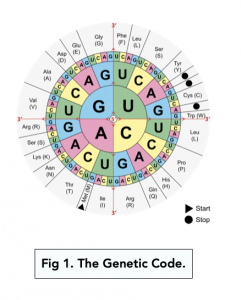
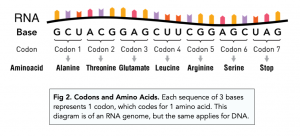
Protein Synthesis Occurs Across Two Stages
Building polypeptides from DNA occurs in two distinct stages. We have covered the relevant RNA involved in the previous tutorial.
- The first stage is transcription. This involves transferring the relevant segments of the genetic code from DNA to a messenger RNA (mRNA) molecule. Transcription takes place in the nucleus.
- The second stage is translation. The newly synthesised mRNA travels into the cytoplasm. With the help of transfer RNA (tRNA) and ribosomes, the sequences in the mRNA are used to build the polypeptide.
Transcription
Remember that the purpose of transcription is to create an mRNA version of the relevant segment of DNA. This is because ribosome, the organelle responsible for synthesising proteins, is in the cytoplasm but DNA is in the nucleus. DNA cannot travel outside of the nucleus as it is too large.
- At the start of transcription, the DNA molecule is separated into two strands by RNA polymerase. Transcription starts similarly to DNA replication where the DNA double helix is unwound. This is done by the enzyme RNA polymerase which binds to the DNA and breaks the hydrogen bonds between bases.
- Transcription begins at the promoter region. At the beginning of each gene, there is an area called the promoter region which signals to the RNA polymerase that this is where the process of transcription should start.
- The opposite strand to the strand that should be copied serves as the template. Imagine that there is a section of DNA we want to copy. If we start building our mRNA by recruiting nucleotides onto that strand, we will end up getting mRNA that is complementary to our strand of interest rather than one that is identical to it. Thus, the opposite strand to the one we want to copy is used as a template upon which the mRNA is built.
- The template strand is called the antisense strand, and the original strand of interest is called the sense strand. The mRNA is built upon the antisense strand, and will be identical to the sense strand (except it will have the base uracil instead of thymine).
- RNA polymerase builds the RNA molecule. RNA polymerase recruits free nucleotides to build the mRNA molecule via complementary base pairing to the antisense strand and catalyses condensation reactions between the nucleotides.
- RNA polymerase works in a 5′ – 3′ direction. Similar to DNA polymerase, it can only construct the mRNA molecule in a 5′ – 3′ direction. It also proofreads as it adds the bases.
- Transcription ends at a terminator region. The RNA polymerase will eventually reach an area on the DNA called the terminator region. This signals the end of the gene. The RNA polymerase will then release the completed mRNA strand and rewind the DNA double helix.
- The mRNA molecule that is formed undergoes editing to become the mature mRNA. We have previously established that there are non-coding sequences in genes. These are called introns and are removed after transcription of a gene. Only coding sequences, called exons, remain in the mRNA. These are then linked together to form the mature mRNA, which leaves the nucleus and moves to the cytoplasm.
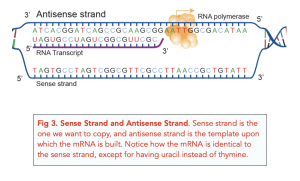
Translation
The mature mRNA will now be used as a template to create the polypeptide chain.
- Protein synthesis occurs in ribosomes. Ribosomes are cellular organelles where polypeptides are synthesised. Remember from the previous tutorial that ribosomes consist of a large and small subunit, each of which are made of ribosomal RNA (rRNA).
- Translation begins at the start codon. mRNA will bind to the ribosome. Then, a tRNA molecule, carrying a specific amino acid on one end, will recognise the start codon (i.e. the start signal) of the mRNA strand and bind to that via its anticodons. Remember from the previous tutorial that the bases in a tRNA’s anticodon is complementary to bases in the mRNA’s codon.
- Another tRNA joins to the next codon of the mRNA. A second tRNA molecule, carrying the amino acid specified by the next codon in the mRNA sequence, will come and bind to the mRNA.
- Ribosome catalyses the peptide bond formation. Now that there are two amino acids next to each other, the ribosome will help catalyse the formation of a peptide bond between these two monomers.
- The tRNA are released and the process repeats. Once the peptide bond is formed, the tRNA are free to leave the ribosome and recruit other amino acids needed to build the polypeptide. They then return with new amino acids and bind to the mRNA at corresponding codons, and the process of forming peptide bonds between the amino acids repeat.
- Translation ends at the stop codon. There are no tRNA molecules that have anticodons corresponding to the sequence in a stop codon. Thus, once a stop codon in an mRNA is reached, the process of synthesising the polypeptide chain is terminated.
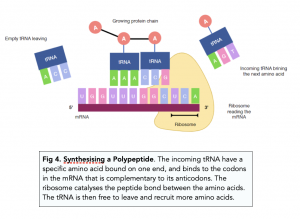
Mutations
- Mutations occur when the sequence of bases in a gene becomes altered. This is caused by mutagenic agents such as chemicals and radiation.
- The mutation results in a wrong polypeptide chain being made. If the gene in a DNA molecule gets altered, then this change will carry through when the mRNA molecule is made, and will cause the wrong amino acids to be added during translation, thus the wrong polypeptide chain will be made.
Types of Mutations
There are different types of mutations:
- Some mutations are “deletions” i.e. one or multiple bases get deleted from the gene. This will produce a shorter polypeptide than intended as the genes coding for some of the amino acids are missing.
- “Substitutions” are when one or multiple bases in the original gene get swapped for another. This means the length of polypeptide will remain the same but with wrong amino acids as its constituents.
- “Insertions” are when one or multiple bases get added to the original gene. This causes a longer polypeptide to be made with additional amino acids which should not be present.
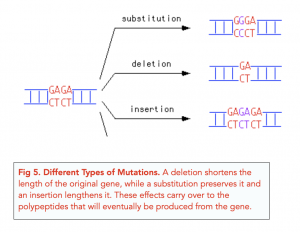
- Point mutations are when deletion/substitution/insertion occurs to a single nucleotide only. This can be seen in sickle cell anaemia in humans, where red blood cells are abnormally shaped like a crescent rather the usual biconcave disc. This occurs due to a point mutation in one of haemoglobin’s proteins, where the original glutamic acid is substituted by a different amino acid, valine. This changes the overall structure of the protein and distorts the shape of the red blood cell, leaving it unable to carry oxygen efficiently.
FAQs
DNA stands for Deoxyribonucleic Acid and it is the genetic material that contains all of the information needed to make the proteins that are necessary for life.
DNA provides the blueprint for the production of proteins. This blueprint is in the form of a sequence of codons, which are made up of three nucleotides, that specify the order of amino acids that make up a protein.
Transcription is the process by which the information stored in DNA is copied into RNA. This involves the use of an enzyme called RNA polymerase, which unwinds the DNA double helix and adds complementary RNA nucleotides to the exposed template strand.
RNA acts as a messenger between DNA and the ribosome, which is where proteins are synthesized. The RNA molecule carries the genetic information from the DNA to the ribosome, where it is translated into a sequence of amino acids.
Translation is the process by which the genetic information stored in RNA is translated into a sequence of amino acids to form a protein. This process takes place in the ribosome and is facilitated by transfer RNA (tRNA) molecules, which bring the amino acids to the ribosome and add them to the growing protein chain.
Ribosomes synthesize proteins from RNA by reading the sequence of codons in the RNA molecule and adding the corresponding amino acids to the growing protein chain. This process continues until the ribosome reaches a stop codon, which signals the end of the protein synthesis.
Enzymes play a key role in protein synthesis by facilitating the processes of transcription and translation. RNA polymerase, for example, is an enzyme that is responsible for catalyzing the transcription of DNA into RNA, while ribosomes and tRNA molecules are enzymes that catalyze the translation of RNA into proteins.
DNA ensures the accuracy of protein synthesis through a number of mechanisms, including proofreading by RNA polymerase during transcription, and quality control mechanisms in the ribosome during translation. These mechanisms help to ensure that the genetic information stored in DNA is accurately transferred to RNA and then to proteins, and that any errors in the DNA sequence are corrected.





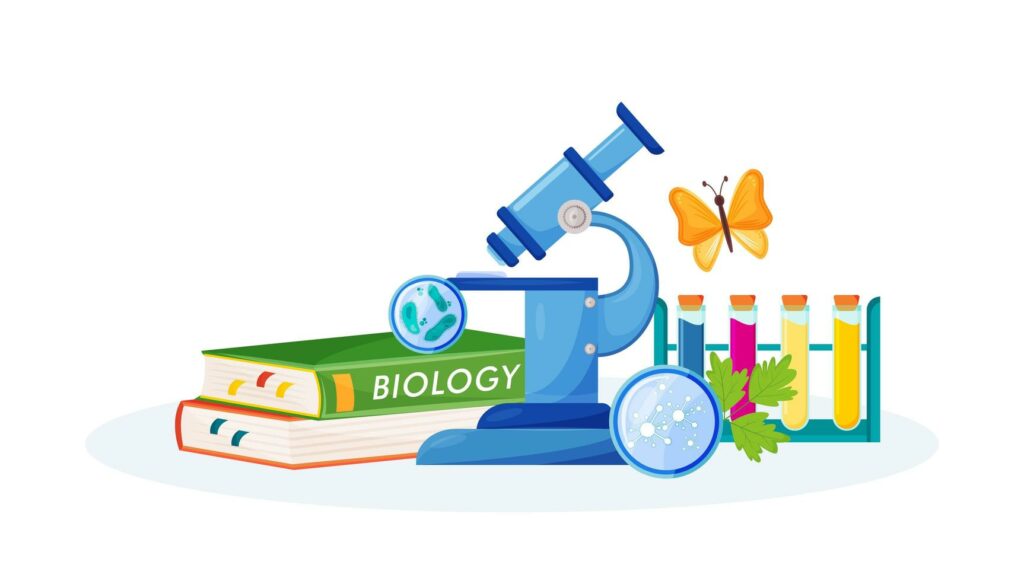
Still got a question? Leave a comment
Leave a comment